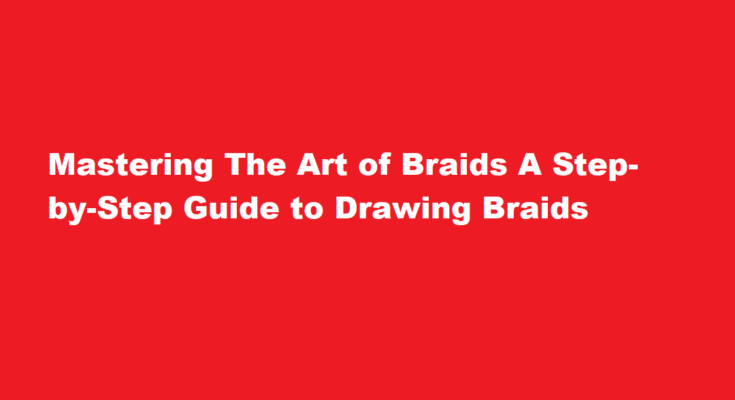Introduction
Braids, with their intricate patterns and timeless beauty, have been a popular hairstyle for centuries. But did you know that you can capture their elegance on paper too? Drawing braids can be a rewarding and creative endeavor for artists of all skill levels. In this step-by-step guide, we will explore techniques and tips to help you master the art of drawing braids. Whether you’re a novice looking to improve your skills or an experienced artist seeking to add a new dimension to your work, this article has something for everyone.
Materials You’ll Need
Before we dive into the world of braids, let’s gather our materials
1. Pencils A range of graphite pencils (2H to 6B) for sketching and shading.
2. Erasers A kneaded eraser and a standard eraser for corrections.
3. Paper High-quality drawing paper or sketchbook with a smooth surface.
4. Blending Tools Blending stumps, tortillons, or even your fingers.
5. Reference Images Photos of braided hairstyles or tutorials to study the structure.
Understanding the Basics
To draw braids convincingly, you need to grasp their fundamental structure. Braids are created by weaving strands of hair, fabric, or other materials together. The key elements include
1. Strands The individual sections that make up the braid.
2. Weave Pattern How the strands interlace with each other.
3. Tension The tightness of the braid, affecting its thickness.
4. Texture The surface quality, which varies based on the materials used.
Step-by-Step Guide
1. Start with the Base
Begin by drawing a simple guideline or outline for the braid. This can be a straight or curved line, depending on the braid’s shape.
2. Divide into Strands
Sketch evenly spaced lines along the guideline to represent the strands. For a classic three-strand braid, draw three lines. Adjust the number of strands for more complex braids.
3. Weave the Strands
Imagine the strands as three separate ribbons. Start weaving them over and under one another, maintaining the pattern throughout. For added realism, make sure the weave is consistent.
4. Add Texture
Braids aren’t perfectly smooth; they have subtle variations in thickness and texture. Use your pencil to add these details by lightly shading some areas and leaving others untouched.
5. Enhance Depth
To give your braid depth, use a darker pencil to shade beneath the strands where they overlap. This creates the illusion of shadow and dimension.
6. Refine Details
Pay attention to the finer details, such as stray hairs and irregularities in the weave. These imperfections make the braid look more authentic.
7. Erase and Blend
Use your kneaded eraser to lift highlights and clean up any mistakes. Then, blend the shading and highlights with blending tools to achieve a seamless look.
8. Experiment with Materials
Don’t be afraid to experiment with different materials like colored pencils, charcoal, or ink to add depth and color to your braids.
Tips for Realistic Braids
- Study Real Braids Observe real braided hairstyles to understand how light interacts with the strands and the texture of the hair.
- Practice Regularly Drawing braids can be challenging, so practice is key. Start with simple braids and gradually work your way up to more intricate ones.
- Vary Your Styles Experiment with different braid styles, from classic three-strand braids to fishtails and French braids.
- Pay Attention to Lighting Lighting plays a significant role in showcasing the braid’s texture and depth. Experiment with different lighting angles in your drawings.
- Use References Reference images and tutorials can provide valuable insights and guidance as you hone your braiding skills.
FREQUENTLY ASKED QUESTIONS
Are box braids OK?
It’s been said that some protective styles using extensions, like box braids, can cause damage to the hair or scalp, but Williams says this is only the case if the braids are installed or removed incorrectly.
Are box braids OK for kids?
Knotless box braids are the perfect protective style for kids. Not only will this style last, but adding beads and colored bands will make the styling experience even more fun for your child and create a way to express themselves through hair.
Do braids damage hair?
If the hair is pulled back too tightly, it can break away from its roots, which may result in splitting, hair weakness, and follicle damage, so make sure you keep the start of the braid loose. Braids that are too tight can also cause tensile stress, which occurs when there is constant tugging on hair follicles.
Conclusion
Drawing braids is a delightful art form that allows you to capture the beauty and intricacy of this timeless hairstyle on paper. With patience, practice, and attention to detail, you can master the art of drawing braids and add a unique dimension to your artistic repertoire. So, pick up your pencils and embark on a creative journey that celebrates the elegance of braids.
Read More : A Step-by-Step Guide to Buying Tesla Stock on eToro



